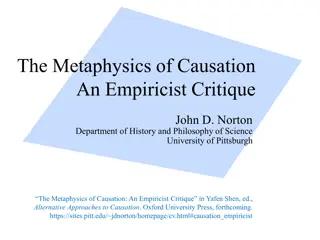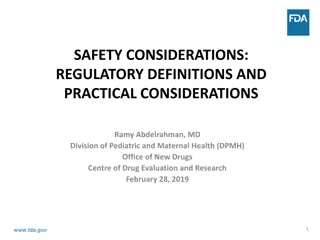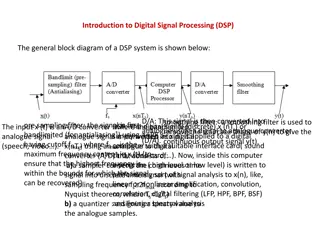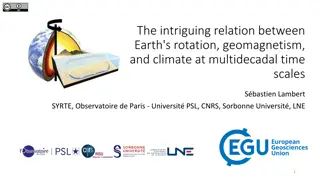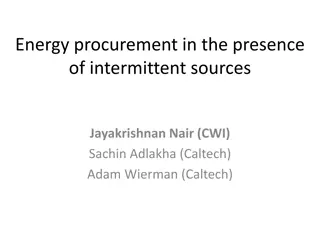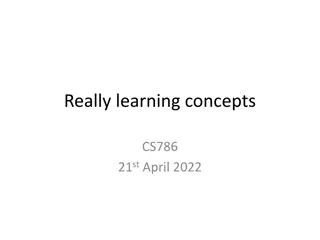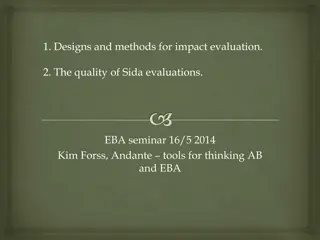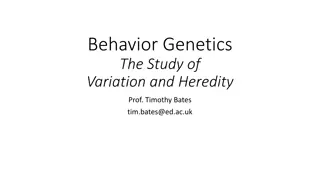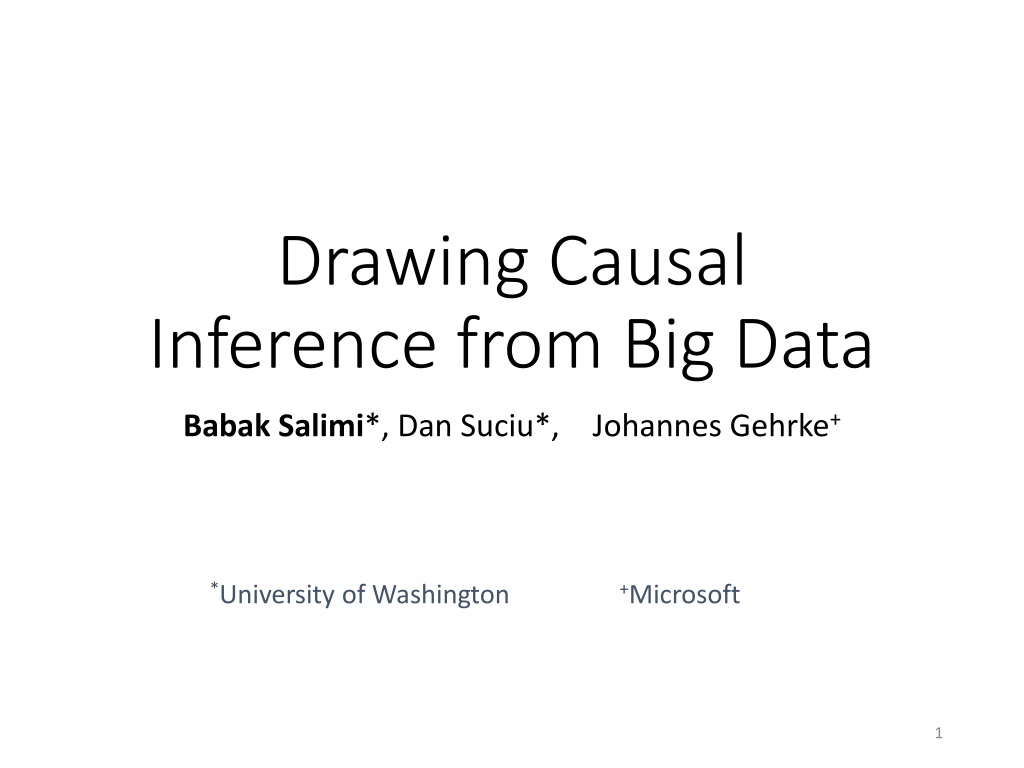
Causal Inference in Big Data Research
Discover the importance of causal inference in performance debugging, health science, social sciences, and marketing. Explore the process of causal inference, its distinction from predictive analysis, and the goal of integrating it into relational databases for scalable analysis. Dive into specific examples like determining the causal effect of weather on flight delays and learn about statistical approaches such as Rubins's causality in SQL.
Download Presentation

Please find below an Image/Link to download the presentation.
The content on the website is provided AS IS for your information and personal use only. It may not be sold, licensed, or shared on other websites without obtaining consent from the author. If you encounter any issues during the download, it is possible that the publisher has removed the file from their server.
You are allowed to download the files provided on this website for personal or commercial use, subject to the condition that they are used lawfully. All files are the property of their respective owners.
The content on the website is provided AS IS for your information and personal use only. It may not be sold, licensed, or shared on other websites without obtaining consent from the author.
E N D
Presentation Transcript
Drawing Causal Inference from Big Data Johannes Gehrke+ Babak Salimi*, Dan Suciu*, *University of Washington +Microsoft 1
Causal Inference is important Performance Debugging: What is the effect of the new version of Postgres (vs. the pervious version) on query runtime, given a population of queries? [VISKA] Health Science: What is the efficacy of a given drug in a population? Social/political Science: What causes ethnic violence? Why are rural people more politically conservative than urban people? Marketing : Evaluating new ideas/policies for a business 2
Causal Inference Causality: X is a cause for Y if by perturbing/intervening X and keeping everything else unchanged we affect Y Causal inference: is the process by which one can use data to make claims about causal relationships Causal vs. Predictive analysis: Predictive analysis P(X,Y) Causal analysis P(Y, Intervening (X)) Fundamentally different! 3
Goal of this Research Causal inference is performed today using statistical software such as SAS, SPSS, or R [MatchIt 2015, CausalImpact 2015,CEM 2016, ] Work well on small, single table Our research: Integrate causal inference in relational database We can perform causal inference with SQL queries Fast SQL queries Scalable causal inference 4
Causal Effect of Weather on Delay What is the causal effect of the Snow Delay? Data: 100M rows; 23 attributes! Outcome Y Treatment T FlightNo Date Origin Snow Visibility Delay DL033 10/10/01 Seattle 0 1 0 AS55 .. Seattle 2 5m .. 1 10 0 .. 0 1 1h Other causal questions: Effect of LowVisibility(Visibility< 2KM), or Windspeed (Wspdm> 32 MPH), or ...? 5
Rubins Causality SQL Single attribute Y Unit (ID) T X(1) X(2) ... Y(0) Y(1) 1 0 A B y1 NULL 2 1 A B NULL y2 (1) SELECT avg(Y(1) Y(0)) FROM R Def. Causal effect = E[Y(1) Y(0)] Problem: missing values! Controlled experiment: E[Y(T) | T] = E[Y(T)] (independence assumption) (2) (SELECT avg(Y) FROM R WHERE T=1) - (SELECT avg(Y) FROM R WHERE T=0) Causal effect = E[Y(1)|T=1] E[Y(0)|T=0] Problem: our data is not randomized! (Observational Data) Strong Ignorability: E[Y(T) | T,X] = E[Y(T)|X] (3) AVG[ (SELECT avg(Y) FROM R WHERE T=1 GROUP BY X) - (SELECT avg(Y) FROM R WHERE T=0 GROUP BY X) ] Causal effect = EX[E[Y(1)|T=1,X] E[Y(0)|T=0,X]] Data processing: retain only groups with both T=0 and T=1 (subclassification/matching) Problem: homogeneous groups! 6
Subclassification in SQL CREATE VIEW Subclassification Subclassification : retain only groups with both T=0 and T=1 WITH subclasses AS ( SELECT *, max(ID) FROM GROUP BY X HAVING max(T)!=min(T) ) R SELECT * FROM subclasses, R WHERE subclasses.X = R.X 25x speed up! The query takes more than an hour on the entire data! Can we do better? 7
Subclassification queries are important CREATE VIEW Subclassification WITH subclasses AS ( SELECT *, max(ID) FROM ? ?1, ,?? GROUP BY ? ? = {?1, ,??} HAVING Arbitrary Property ? ) ?,?? = ? ??? ?(?)} SELECT * FROM subclasses, R WHERE subclasses.X = R.X They have certain algebraic properties that enable us to perform them much faster! Important class of queries! Data Mining (Iceberg Queries ) Discovery of FDs Statistical methods 8
Effect of weather on flight delay George Bush Intercontinental Airport (IAH) San Francisco International Airport (SFO) 9 [https://weather.com/]
Algebraic Properties (monotone ? ) (Intersection) ?? ??,? ? ??,?? ??,?(?) Start pruning wrt. larger groups (Refinement)Si ?? iff ??,?(?) ??,?(?) ? ? denotes ?refines?, i.e., if every element of ? is a subset of some element of ? (Entailment) ?,??? ?,??? , If ?? ?? (Factorization) ??,??? ?1 ??,?1 ?? ? for ? SBQs ??,??? Start pruning the shared attributes between all groups and disjunction of aggregate conditions 10
Algebraic Properties (monotone/decomposable? normalized data ) For any ? ?, let ? = ??1 ??2 ??? where ??1 ???, for any decomposable ? (Modularity) ?,? ? = ??1,?1?1 ??2,?2?2 , , ???,???? Filtering can be pushed down to the base relations (Reduction) ?,? ? = ??1(???1) ??2 ?( ??1(???1)) , , ??????? ??? 1(???? ) ???2 ?? ?([?]) ? flatten ? ?(??) = ???,???? We can perform semi-join reduction 11
Factorization for multiple queries Causal queries: T1:LowVisibility; T2:HeavySnow; T3:SnowStrom; T4:Windspeed; T5:Thunder; Partition treatments (heuristic) G1={T1, T5} G2={ T2,T3,t4} Prune wrt. each group (Shared attributes, disjunction of the treatments) Impose the original queries to the pruned data 10x speed up! After pruning we can run several SBs wrt. Different treatments for different subsets of the data 12
Modularity and Reduction reduction Causal queries: LowVisibility; Windspeed; Semi-join the result with the flight table Decompose data into flight and weather tables Filter weather table wrt. a treatment e.g., Low visibility Filter the reduced flight table; join with the filtered weather table 2x speed up! 13
END 14


